In Dungeons and Dragons 5e, a Black Pudding is one of the deadliest Oozes in the Monster Manual. Should you tackle them unaware, you will find yourself without a weapon or armor at best; and lacking life or a party to revive you at worst. This guide will not only go over why Black puddings are so corrosively deadly but why they are fantastic creatures and where you can find them.
Where deadlier oozes derive their TPK skills from tactic and magical abilities, the Black Pudding is pure hunger and instinct. The Apex Glutton needs only an inch of space to ooze into your room and leave no trace behind once your party wakes up.
Should they not fall prey to the Black Pudding. It knows they are there after all and is confident they are food. Welcome to a Black Pudding 5e Guide.
The Black Pudding; Feral Oozing Gluttony
Black Puddings resemble tar or sticky black sludge. It blends in with dark surfaces so well it can be mistaken for a shadow to the unaware. A pudding, in particular, prefers flesh and bone. It is dissolved in a Black Pudding as if dipped into acid; stone is unaffected though thoroughly cleaned.
An ooze functions in form and digestion to an amoeba. However, the most dangerous aspect of a Black Pudding that not all oozes share is their ‘reproduction’ method. If hit with lightning or and slashing weapon, you now have two Pudding to deal with.
This is derived from the Pudding’s cellular makeup. Rather than individual cells making up a whole like a multi-cellular creature, a Black Pudding is more of a colony of single-celled organisms combined into one deadly being.
An ooze is capable of instinctively finding living creatures that produce heat. Warm-bodied creatures are the most nutritious to oozes, and they will slowly slink for the nearest source. The more organic material it can consume, the larger it becomes.
- An ooze does not require sleep.
- Not all oozes dissolve the same sources of matter. Their diet influences the differences in oozes as much as their color.
- An ooze lacks intelligence but follows predictable patterns. Many cunning creatures use this to their advantage in creating traps and arming dungeons.
- To be eaten by an ooze is a slow and painful death, but a pudding is incredibly dark. To be eaten by a pudding means your party might never know a friend is inside.
- Successful Black Puddings are often sizzling with magic loot.
- Black Puddings will not merge upon meeting.
- Black Puddings can dissolve and corrode nearly anything, but they require flesh to survive.
- Their corrosive nature is derived from their excreted digestive juices.
- A Pudding needs low levels of oxygen to survive. It can obtain that oxygen from sources of water.
- While capable of surviving underwater, its acid is diluted, it can’t float, and its blind sense is dramatically reduced.
- As of the fifth edition, Black Puddings are no longer immune to fire or piercing damage.
Stat Block
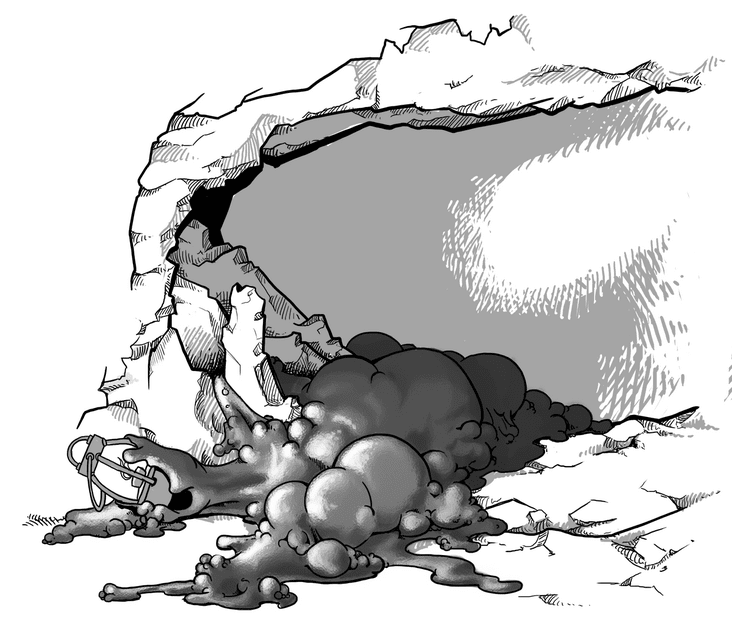
Black Pudding
Large Ooze, Unaligned
- CR 4 (1,100 XP)
- Passive Perception 9
- AC: 7
- Hit Points: 85 (10d10+30)
- Speed 20 ft, climb 20 ft
- Str: 16 (+3)
- Dex: 5 (-3)
- Con: 16 (+3)
- Int: 1 (-5)
- Wis: 6 (-2)
- Cha: 1 (-5)
- Damage Immunities acid, cold, lightning, slashing.
- Condition Immunities blinded, charmed, deafened, exhaustion, frightened, prone.
- Senses: blind-sight 60 ft, blind beyond 60 ft.
- Languages: NA
Amorphous

An ooze can move through spaces as narrow as 1 inch wide without squeezing.
Spider Climb
An ooze can climb complex surfaces without needing to make an ability check. This includes upside down and sideways.
Corrosive Form
A black pudding can each through 2-inches of nonmagical wood or metal in one round.
Touch 5 ft
Touching the Pudding or hitting the Pudding with a melee attack while in range will activate this effect.
Hit 4 (1d8) acid damage.
This effect corrodes any nonmagical item made of metal or wood. After dealing damage to the ooze, the weapon takes a permanent and cumulative -1 penalty to damage rolls.
If a weapon’s corrosive penalty hits -5, the weapon is destroyed.
Nonmagical ammunition that hits the Pudding is destroyed by the ooze after dealing damage.
Actions
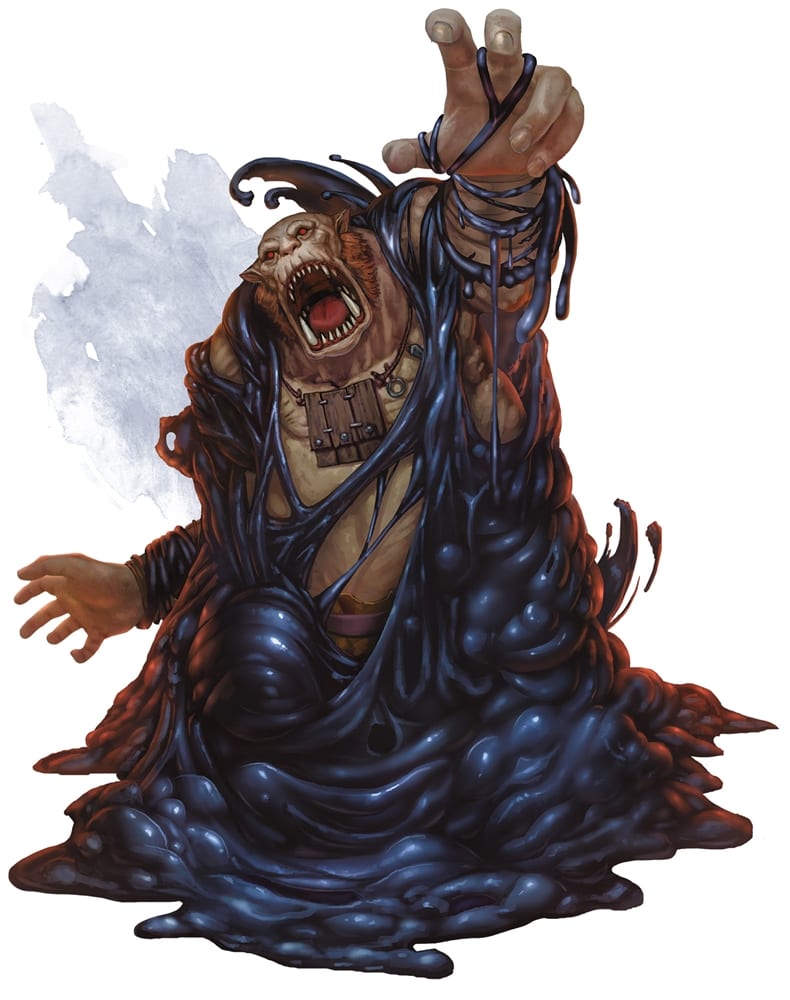
Pseudopod
- Melee Weapon Attack: +5 to hit
- Range: 5 ft, one target.
Hit 6 (1d6+3) bludgeoning damage plus 18 (4d8) acid damage.
Upon a successful hit, nonmagical armor worn by the target takes a cumulative and permanent -1 penalty to the AC it offers. The armor is considered destroyed if this penalty reduces the target’s AC to 10.
Reactions
Split
So long as the Pudding has at least 10 hit points, it will split into two Puddings when it is struck by lightning or slashing damage.
These new puddings have half the hit points of the original Pudding, rounded down. Further, they are one size category lower than the initial Pudding.
Black Pudding Biology
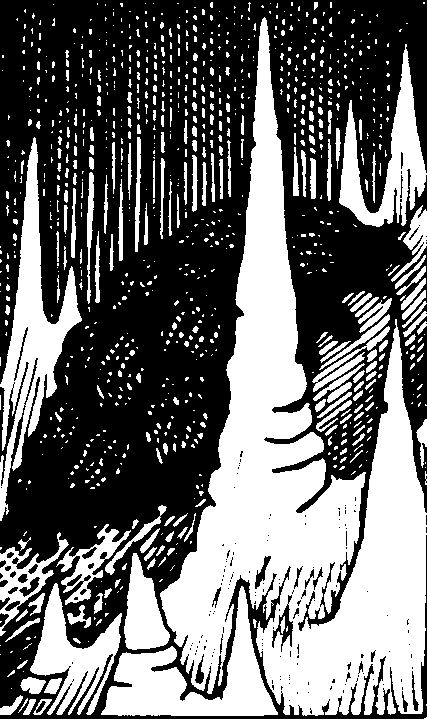
A Black Pudding is not a Multi-cellular creature in the usual definition. Rather than center around a central ‘cell’ or consciousness, the Black Pudding is a hive colony of single-celled creatures. They work toward a universal goal which is to consume and grow.
While the cells work together to hunt for prey, they do so as a herd rather than a connected mechanism. A slurry of hunger rather than a workforce. With no central core that the cells rely on collectively for nutrients and commands, the Pudding can be split without issue.
While lacking conventional sapience, they have the instinctive intelligence inherent to living organisms. They innately understand that they are more effective as a whole and instinctively resist being split unless sliced or exposed to electricity.
That does not mean they will grow endlessly, however. The Black Pudding has a natural limit to how large its hive/a black Pudding can grow. Once they hit 8-9 feet, they will split as the closest thing the creature has to natural reproduction.
These creatures do not understand the motivation for attacking, nor are they intelligent enough to understand the potential for further attacks. Therefore, it will continue to attack even if it is not in its best interest due to continued splitting or low health. The Black Pudding will continue to attack anything made of flesh until it is digested or the Pudding is destroyed.
Puddings are incapable of eating each other and will not fuse into a larger Pudding upon meeting each other.
Diet
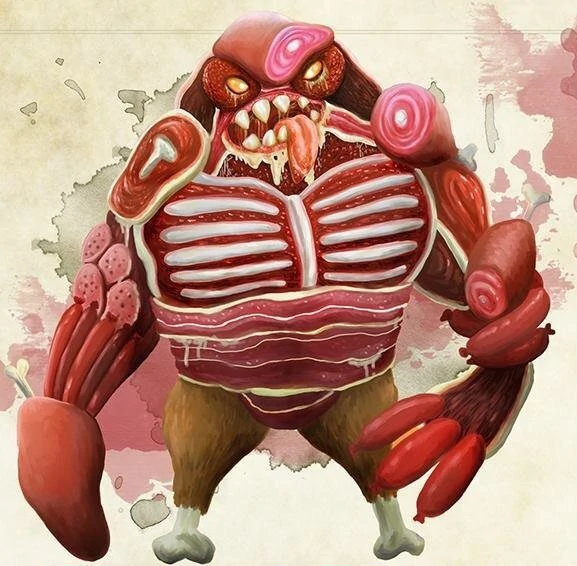
While a Black Pudding is capable of corroding nearly anything as if it were acid, it does not gain a large amount of sustenance from it. While it might idly chew on wooden beams if it hasn’t found flesh in a while, the flesh is what it craves. Living flesh is preferred, but it isn’t all that picky. Cadavers are full of meat and juicy, living insects anyway.
Wood, metal, and other material it corrodes within itself will allow it to function. Still, it does not gain enough nutrients to fully maintain itself. If a Pudding cannot find and digest flesh for a long enough period, it will wither and die.
Villains seeking to use black puddings as traps should account for this, as they will find their puddings escaping or withering.
Acidic Saliva
To eat these nutrients, a Black Pudding has distinct spots it can consume something from. Being within the mass of the colony will corrode and dissolve anything like acid. However, the nutritious sludge needs to be near these points for the Pudding to derive sustenance from it.
Instead, this is derived from the digestive juices these points, or ‘mouths,’ excrete. Without first dissolving the creature into a slurry of nutrients, these tiny mouths would be unable to eat it.
In this manner, it is similar to saliva. However, it is through this digestive juice that a Black Pudding gains its acidic nature.
Regardless of the size of the Black Pudding, the number of these absorption locations never increase. As such, nor does the potency of the acid. For this reason, a small pudding and a fully grown pudding all do the same amount of damage.
Blind but Efficient
Not all oozes are made the same; among them, Black Pudding is a particularly well-evolved foe. While it may be blind, it can use its blind sense to detect heat.
Furthermore, their blind sense is so acute that they can discern the material makeup of the items within their blindsight radius. This allows it to efficiently distinguish if what it is pursuing is edible or not. Finally, it is so evolved compared to a Gelatinous Cube that it will avoid obstacles it would otherwise consider dangerous such as lava.
This gives a Black Pudding an advantage over other oozes. An adventurer might mistake its low intelligence score to mean it has poor survival instincts like a creature such as a Gelatinous Cube.
They are not intelligent enough to assess or ponder the specifics. For example, it does not care about the intricate differences between wood, metal, stone, and lava. It merely understands that the wood and metal can be corroded and hold small sustenance value while the stone and manga (hot stone) do not.
It has no understanding of something attacking it or concepts of magic.
It is merely hungry and knows you are edible.
Sun-Aversive

A black pudding is black as tar or asphalt. Due to this issue, Black Oozes generally avoid being outside as it does terribly for their chances of survival. A day of exposure will effectively dry a Black Pudding out thanks to how effectively it absorbs the sunlight and heat.
This does not initially kill the Black Pudding. It instead makes it far less effective as a hunter. Its acid dries, and, like cotton mouth, eating becomes a struggle. A Black Pudding can slowly find sustenance but once thoroughly dried out; it will be unable to move effectively. If at all.
Dried-out Black Puddings can still threaten unwary travelers, as there is no certainty one has died of starvation yet. However, your desire to poke or harvest it might be all it needs to squeeze out some acid, begin feasting, and quickly rejuvenate itself into a problem.
Underwater ‘Capable’
A Black Pudding can pull oxygen from water. Thanks to this, a Black Pudding is capable of surviving underwater. The trade-off is that they become highly inefficient compared to their predatorial apex outside the water.
Water will dilute a Black Pudding’s acid, making it about a fourth as effective. While their blind sense will have interference from the water, making them only able to ‘see’ half as far. Further, they don’t float. Chucking them into the sea is essentially a time-out, and they’ll likely sludge off in the wrong direction chasing a crab.
While plenty of creatures linger on the ocean floor, it is not effective enough in the long run for any Pudding to actively seek out a life unda’ the sea.
Tenacious Tactics
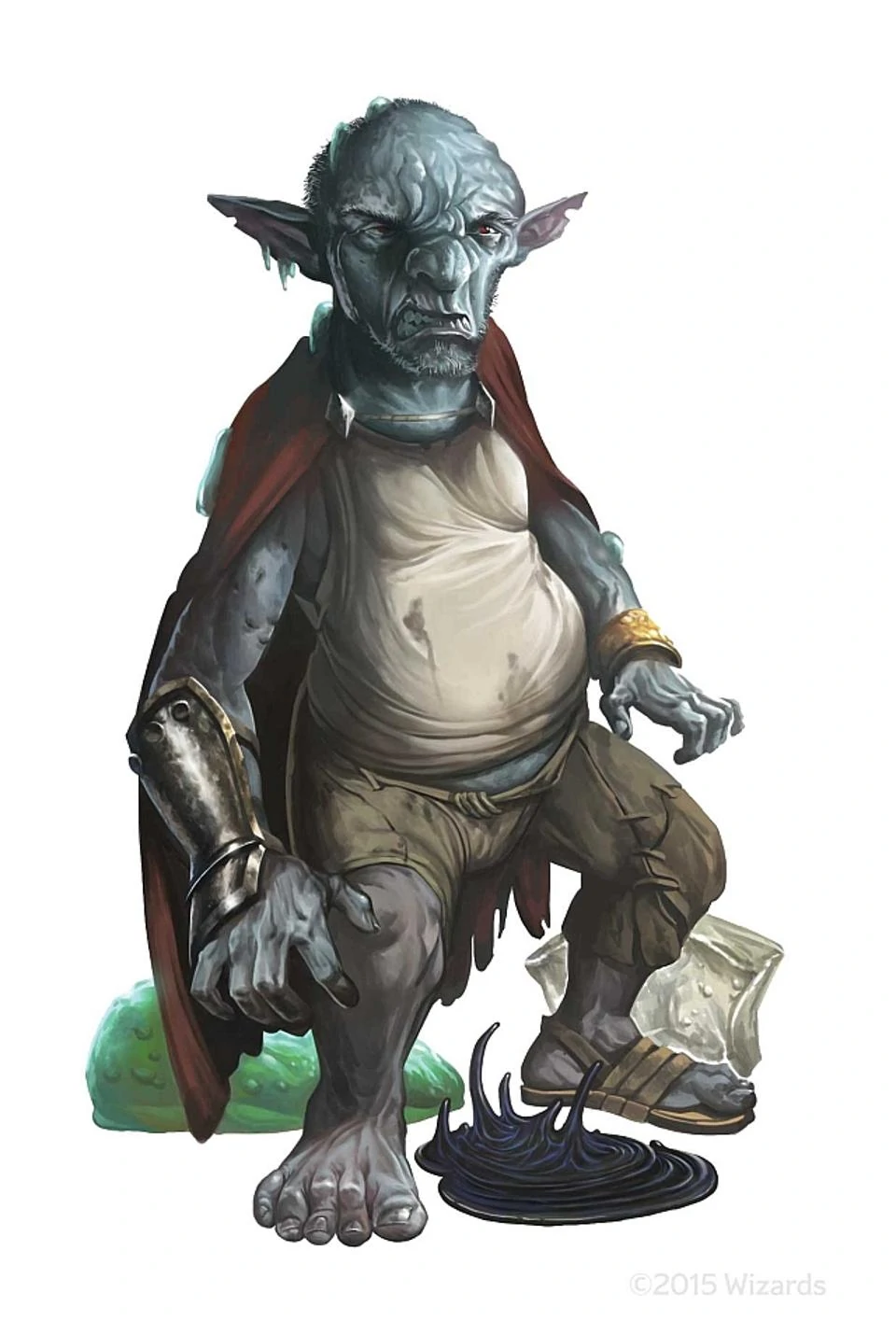
A Black Pudding has no advantage to stealth and a low dexterity. However, that does not mean it can’t ambush a party. Where the 5th edition removed some of its capability for stealth, a Black Pudding doesn’t need a sneak attack or surprise round to get the jump on a party.
Thanks to being dark to the point of appearing to consume light itself (it doesn’t), a Black Pudding can be easily mistaken for the shadow of a rock or a sea of bubbling tar. Even perceptive Birds of Prey fall prey to the camouflage and distraction of an insect.
A pudding doesn’t need nor care if you do not see it. It will slink around merely because it is physically incapable of moving any more dexterously. Not because it is a perfect rogue.
A Black Pudding will not make noise, as it will just sludge over and around anything it doesn’t simply pull into its mass. It just hugs the ground and moves like magma might if it had a tiny bit more gumption.
A Black Pudding is sludging darkness. It doesn’t need an advantage or a dexterity roll. Failure means nothing to it; it will keep coming whether you’ve seen it or not. It simply isn’t capable of caring.
It is said that even if you spread broken glass on the ground, you would not hear a single crack nor cause them much issue. This is because puddings will ooze around it, never slice nor pierce themselves, and dissolve the edges before a problem or noise is made.
Forbidden Treasure

The upside to oozes, including Pudding, is that they can not corrode or dissolve nonmagical items. As well rocks, but that isn’t the significant bit. Anything an ooze can not eat will be stuck inside its growing form until some wise adventurer works out how to get it out without adding to the collection.
Forbidden Flavor
Many oozes are edible to powerful magical creatures. Puddings might be significantly corrosive, but monsters like Shadow Dragons have found addiction to them among their kin. A particularly wise adventurer might be able to find a way to counteract their destructive properties for an edible treat.
The irony is the only ooze named after food is also the most likely to eat you while you eat it. Some creatures consider this akin to spiciness.
Pudding Types
Black Puddings are some of the most well-known of the puddings due to their infamy and preferred biome. Their tendency to linger in dungeons and caves means it is only a matter of time before an adventuring party or guild stumbles across the nightmare they’ll base many a story around.
Other types of puddings that share numerous specific qualities of this type of ooze exist. Many of these have not been added to 5e updated supplements, so I will keep this brief. For even more variants of Puddings and Oozes, see the FAQ for my suggested supplement.
Fifth Edition has so far only listed the tar-like Black Pudding. Still, since Second Edition, four ‘official’ types have been classified. Black, Brown, Dun, and White.
Brown Puddings
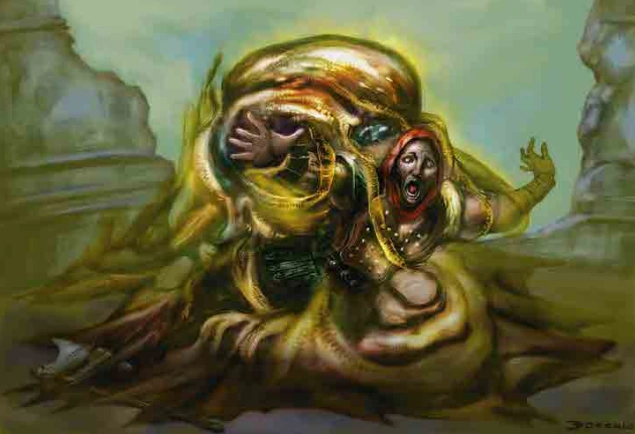
Brown as mud, Brown Puddings can be found in marshes and swamps pretending to be pools or piles of mud. They are notably resistant to piercing attacks, a trait the black Pudding lacks, making them more durable while having fewer hit dice.
They can eat through leather at a rapid rate but cannot corrode metal at all.
Dun Puddings
Dun Puddings are exceedingly rare, but what isn’t in the desert. Reflecting their environment, Dun Puddings are sand-colored with a hint more yellow.
Like most desert carnivores, Dun’s are scavengers. However, in a pinch, they have the unique ability to survive off of the silicates in the sand. They can eat through hard leather at a far quicker rate than a Black Pudding, but at the cost of being slow at eating through metal.
White Pudding
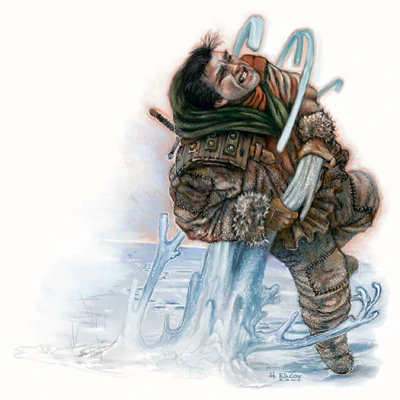
White Puddings exist in snowy biomes such as Tundras and the high peaks of mountains. So long as fauna and flora can still be found among the ice, a white pudding could well enough live there. They are considered by some to be the most dangerous Pudding cataloged.
White Puddings could look like giant piles of snow or, if carrying a slightly bluer sheen, as patches of ice. The polar opposite of their more well-known cousins, a White Pudding thrives in the blinding white environments where it can hide in plain sight until it is too late.
They have evolved to derive nutrients from the snow in a pinch, but like most oozes, they favor flesh and organize matter above all other sources. While unable to corrode or affect the metal in the slightest, they can dissolve organic matter rapidly.
White Pudding Poison
White puddings’ most dangerous aspect is a poison that could be harvested. When a White Pudding’s poison is collected in its potent state, it would be able to be used as a mind-withering poison. In addition, this poison was effective as an aerosol-rendered trap.
Upon failing a DC 15 Con save, the poison was capable of inflicting an initial 4d8 poison damage. Further, the target’s Wisdom and Intelligence scores are both reduced by 1d4+1 points. This reduction will last until cured of the poison. A successful save renders the target immune to White Pudding Poison for 24 hours.
This poison’s efficiency made it an expensive item. The poison alone costs 500 gold, with traps incorporating them able to fetch a kingdom’s treasury alone. Moreover, its ability to wither the mind so dramatically is considered taboo and, generally, horrifying on all points.
For this reason, it can only be found on the black market or in the types of kingdoms that make the surrounding kingdoms nervous.
Juiblex, The Faceless Demon Lord
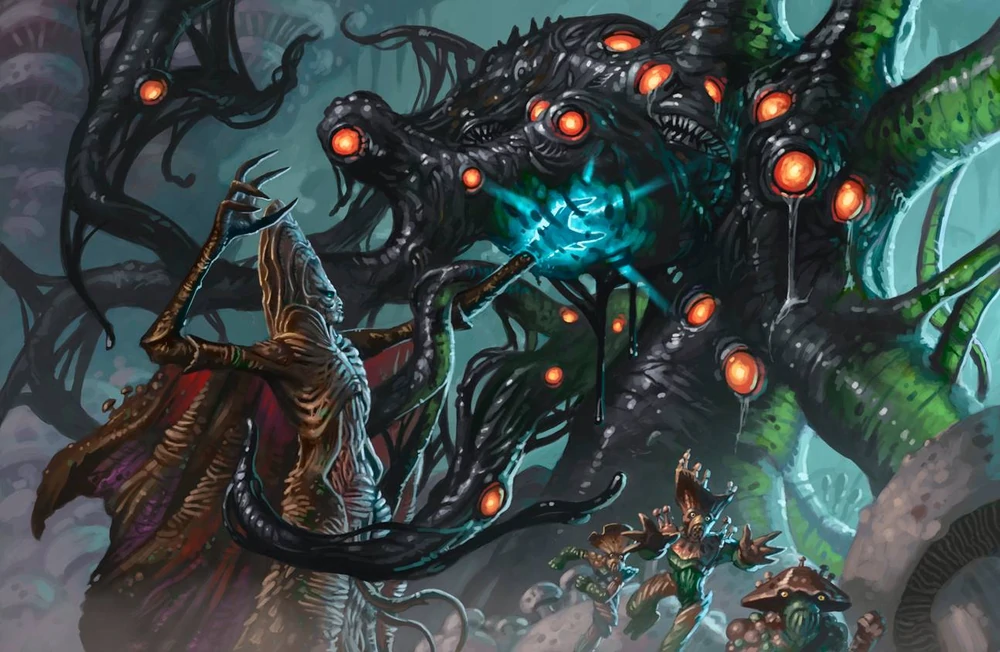
Juiblex exemplifies the acidic and corrosive corruption of the Infinite Abyss. While its peers considered it a ‘Lord of Nothing,’ oozes were instinctually reverent to the creature. It should also be noted that those who dub him a lord of Nothing still do well to stay out of his way.
Juiblex is the Demon Lord of Oozes and Shapeless things. It is theorized by some that the ooze race is made up of wayward fragments of Juiblex’s whole. Whether the truth is they are fragments or offspring, Juiblex can control oozes much like Demogorgon can instinctively control demons.
Most damningly, Juiblex’s presence can gift oozes with a bubbling splinter of greater intelligence. As if regaining a semblance of their old selves by being close to the greater whole.
On that note, Juiblex is notable for an ooze, THE ooze, as having a high intelligence and wisdom score. Both are at 20, so something is going on in that melted mind. Juiblex is also notable for showing that score merely fuels the personality’s derived purpose.
Juiblex, like all oozes, merely lives to consume. While their intelligence and wisdom have given him the ability to hate and react, he is noted for being devoid of schemes or greater plans.
Supposedly.
Demon Princes are notorious for their five-dimensional chess-playing skills, however. Juiblex could conceivable have the Abyss’s greatest poker face, to the point that one of the greatest hive minds could be playing the role of a sludging mindless lord. Furthermore, Juiblex was present during the creation of the Abyss and thus knows secrets of its nature that few are privy to.
Juiblex is said to have been born as an infection of reality. A shard of pure evil stabbed into the Abyss from the elemental chaos, which seethed and oozed into the Faceless Lord. A primordial disease which all Oozes have sprouted from.
Understanding the motives of the most intelligent ooze involves more disassociation than understanding the motivations of plant life. The slow and sludging oozes will, one day, devour everything in the planes should Jubilex be left to his own devices.
Eventually is the keyword. It is hardly a pressing issue; it is safe to ignore it. Surely, this isn’t the thing the Mindflayer fled in the far, far future. That’s conspiracy master talk.
Shedaklah & the Slime Pits
The 222nd layer of the Abyss, this layer is notably unique as being one of the exceedingly rare layers of the Abyss ‘shared’ by two demon lords. The Demon Queen of Fungi, Zuggtmoy, and Juiblex is said to contest their rule of this land.
In truth, the two lords do not actively seek to destroy each other. Instead, Zuggtmoy has taken control above the realm’s ground in its forests and swamps. At the same time, Juiblex seems perfectly at home beneath their feet.
While Juiblex is a powerful demon prince, war is likely just an endless source of food for the hungry one’s vibe. As he supposedly lacks any more significant plans or higher purpose for himself. Juiblex knows he found his throne.
Shedaklah is eternally overcast by sickly multi-colored clouds which blast the landscape with endless storms. This leaves the entire realm humid, with marshes, bogs, and swamps broken up only by toxic forests, slime pits, and other humid horrors.
The realm is covered in fungal, oozy horrors from its two warring princes. Puddings, of course, make up a sizable number of this army, with the hugest concentration being in the territory of Juiblex, the Slime Pits.
Swamp of Oblivion
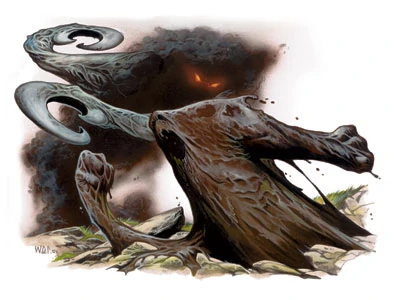
Also known as the Para-elemental Plane of Ooze, the Swamp of Oblivion is the point where the Plane of Earth and Plane of Water intersect. It is kept in a continued state of murky flux as the infinite soil and rock of the Plane of Earth is eroded and sludged through the para-plane into the infinite seas of the Plane of Water.
Few settlements exist in this dimension, with the few beings that populate it being Hags, twisted trees, and leeches. There is no solid ground in the Plane of Ooze. For that reason, it is also home to some of those worst artifacts and forbidden tomes imaginable. As many who have grown to
Thanks to a taste for oozes, Black Dragons have been known to thrive in the Swamp of Oblivion. They often contest the swamp with Brass Dragons to dominate this endless food source.
Overall, while not the worst Plane in the Forgotten Realms to be in it certainly is one of the most unpleasant. This is why Hags have so many summer homes there.
FAQ
Question: Are there any DnD 5e supplements for further information on oozes?
Answer: Noblecrumpet’s Guide to Slimes, Jellies, and Oozes is an outstanding resource for building more from oozes. This third-party supplement expands on the SRD’s lore and stat blocks. From reading through it for further explanations on what the deal with oozes was, I can personally attest to it being a golden tome of inspiration. This isn’t just because Skelly Jelly is the best thing to be named ever. The lore is top tier, there are so many glorious new oozes, and they all are beautifully sketched. For this guide, I focused only on anything that expanded officially established pieces of lore. Then got distracted for hours by the monsters in it.
Question: How do you effectively kill a Black Pudding?
Answer: Fifth Edition has removed a Black Pudding’s immunities to piercing, bludgeoning, and fire damage. Trying to stab an ooze will cost you your weapon in the long run. A Black Pudding is most effectively dealt with using fire, fire magic, magical items, or praying (if you have a cleric). Like most horrors sludging out from the depths, fire is bad.
Question: What is the maximum and minimum size of a Black Pudding? How many Puddings can one Pudding be split into?
Answer: The maximum size a Black Pudding will reach before allowing itself to ‘reproduce’ through splitting is eight to nine feet.
As for the minimum, this is not specified. However, a Pudding will not split if its hit points drop below ten. If you use the hit dice at their maximum to be generous, a Pudding can have at most 130 health at the maximum 8 to nine feet. These hitpoints are rounded down and halves when split, so we will use the same for this monster math.
With this criteria, a slime can split 130-60-30-10 // 9-4-2-1. So should a Pudding not take any damage, as they are immune to slashing damage, they will at most be able to split into eight one-foot creatures with 10 hp.
Conclusion
Oozes, in general, are a staple of DnD. Hallways with suspiciously hovering armor and skeletons slinking about, however, will make your party paranoid. They might start traversing dungeons with a spear leading the way in the traumatic memory of the party pet melted in the previous dungeon.
As benevolent as a Dungeon Master should be, the world should also level up as much as the players. While it will corrode and tarnish, the spear will help kill the Black Pudding you can throw at them, should you be as obsessed with oozes as studying this has made me.
Make sure to poke those suspicious shadow spheres; that movement it is making seems too constant to be merely from the flicker of your torches’ flame.
- Blight 5e Guide: Blood-Thirsty Brambles - August 28, 2022
- Constructs 5e Guide: Intimidating Innovation - August 20, 2022
- Modrons 5e Guide - August 13, 2022

